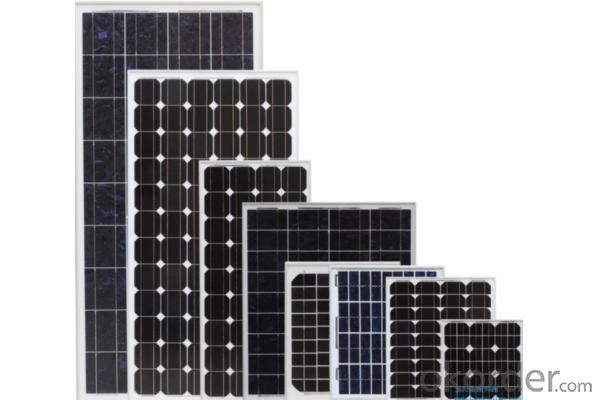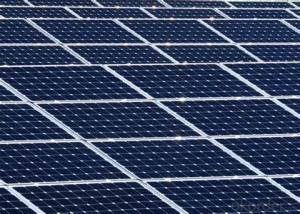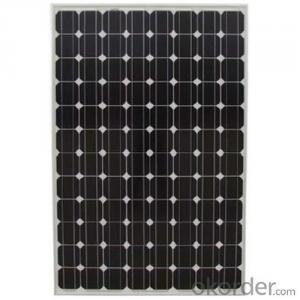200w Poly Solar Module With High Efficiency
- Loading Port:
- Tianjin
- Payment Terms:
- TT OR LC
- Min Order Qty:
- 1 watt
- Supply Capability:
- 100000 watt/month
OKorder Service Pledge
OKorder Financial Service
You Might Also Like
Item specifice
Product Description:
1.Structure of Solar Module Description
CNBM Solar's photovoltaic module is designed for designed for large electrical power requirement. It is the optimal choice for both on-grid and off-grid power systems. CNBM Solar offers high performance of power per square foot of solar array.
2.Main Features of the Solar Module
Solar Cell: High efficency crystalline solar cell. Even if under the weak light, the solar module can produce maximum power output.
Tempered glass: Anti-reflecting coating and high transmission rate glass increase the power output and mechanical strength of solar module.
EVA and TPT: Using high quality EVA and TPT to prevent destroying and water.
Strong aluminum frames to strengthen the load hold and to stand against high wind.
Junction box: Multi function junction box with water proof.
Long lifetime: ≥25 years; Less power decrease.
Good performance of preventing from atrocious weather such as wind and hails.
Resisting moisture and etching effectively, not effected by geology.
The certificate issued by international authority: UL, TUV, IEC, VDE, CE.

Solar panel working process
In addition to being the ultimate source of all life on earth, the sun is an infinitely renewable, completely pollution-free source of electricity. Instead of burning fossil fuels dug up from the ground in a big power plant – a very 19th century, industrial age approach, when you think about it – solar panels convert sunlight directly into electricity, with no harmful emissions.
The basic unit of a solar panel is a solar cell, which usually consists of one or two layers of silicon-based semiconductor wafers. When struck by the photons in sunlight, the solar cell generates an electrical charge due to the "photovoltaic effect" – which is a pretty good name, since it produces voltage from photons. The flow of these electrons moves in a steady electrical current from one side of the cell to the other.
Dozens of these PV cells are packaged together into solar modules, which in turn are packaged into solar panels that are mounted on a rooftop and arranged to maximize their hours of exposure to direct sunlight. Because the electricity generated by all those solar cells is direct current (DC), it is then sent to an inverter that transforms the power into the same alternating current (AC) used by the appliances in your home and the local utility electricity distribution grid. Increasingly, these inverters are getting "smart," providing data monitoring for solar installation performance and other grid integration services.
- Q:How do solar panels affect the property's branding and marketing?
- Solar panels can have a positive impact on a property's branding and marketing. By showcasing a commitment to sustainability and renewable energy, solar panels can enhance a property's reputation as an eco-friendly and socially responsible establishment. This can attract environmentally conscious consumers who value green initiatives and differentiate the property from competitors. Additionally, promoting solar panels in marketing materials can help create a unique selling point, increasing brand recognition and appeal to a wider audience.
- Q:Are solar panels affected by shade?
- Yes, solar panels are affected by shade. Shading can significantly reduce the efficiency and overall energy production of solar panels. It is important to ensure that solar panels are installed in areas with minimal shade to maximize their performance.
- Q:How much space do I need for solar panels?
- The amount of space required for solar panels depends on various factors such as the size and type of panels, the efficiency of the panels, and the energy needs of your household or facility. On average, a 1 kW solar panel system typically requires around 100 square feet of space. However, it is best to consult with a solar installer or expert who can assess your specific requirements and provide accurate information regarding the space needed for solar panels.
- Q:Can solar panels be used during a power outage?
- No, solar panels cannot be used during a power outage unless they are connected to a battery storage system. Without a battery backup, solar panels will also lose power when the grid goes down.
- Q:So lets say that Everyday I use ,280 kWh. How many 250 watt solar panels would I buy so that I don't need to buy electricity anymore. Sorry if this sounds stupid, I am doing research on why american homes should become more cost efficient.
- Everyday I use ,280 kWh 280 kW-hour / 24 hours = 470 kW WOW, that is a very high power level, most homes use an average of .2 kW. My guess is that you mean you use 280 kW-hour in a year, which comes to an average power of .3 kW, typical. Assuming you get, worse case, 6 hours of sun per day, for the first case, 470 kW, each solar panel generates the equivalent of 250 x6/24 = 60 watts, so you would need 470k/60 = 8000 panels For the second case, .3 kw or 300 watts, divided by 60 that is about 20 panels. Depending on where you live, you could need as much as twice that number. Plus you need charge controller, lots of expensive batteries, and an inverter. The big problem is periods of no sun. If you demand continuous power, and you have a period of, say, 24 hours with no sun because of storms, etc, then the number of batteries increases to the hundreds.
- Q:Can solar panels be installed on a car or electric vehicle?
- Yes, solar panels can be installed on a car or electric vehicle. These panels can be mounted on the roof or other suitable areas of the vehicle to capture sunlight and convert it into electricity, which can then be used to power various components or charge the vehicle's battery. However, the amount of energy generated by these panels may be limited, and they are typically used as a supplementary source rather than a sole power provider for the vehicle.
- Q:I want to add solar panels to my home. I was looking online and it seems there are so many different kinds! How does it hook up to the electrical grid? How much do I need for a 2000 sf home?
- This is still not a trivial project, although it is getting easier. The usual way to do this is to contact professional installers for free quotes. In the process of getting the quote, you'll learn what considerations go into sizing a solar system. They'll look at your energy usage, and also whether your house has a good, clear, south-facing roof that doesn't get shaded during the day. They'll also look at your electrical panel to see whether they can hook right up, or additional work is needed. There are rumors of companies like Akeena planning to sell panel kits in Home Depot (in areas that Akeena does not directly serve). The idea would be that a pro installer would pick up the kit there, but a highly skilled homeowner might be able to make it work. A permit will probably be required by your jurisdiction, but that's no different than applying for any other construction. And you'll have to inform your power utility in advance, which may or may not be routine, depending on how often people connect solar in your area. If you want to see how we connected our system, a link is below. I did not really save money by doing it myself. That's because pro's can get better prices on the panels, which makes up for the labor cost.
- Q:What is the biggest solar panel you can buy?How much energy can it produce in kwh?Thanks :)
- Depends upon the technology, but keep in mind that biggest may produce the most output per panel but smaller panels may have a higher efficiency factor and so produce more per sq meter. Solar Integrated Technologies:SI-G 864 - STC 864W Thin Film Roofing Membrane - PTC 779.8 Watts ENN Solar Energy: EST-480 - STC 480W Thin Film Tandem Junction Module - PTC 440.6 Watts SunPower:SPR-445J-WHT-D - STC 445W Monocrystalline Module - PTC 42.7 Watts Topsun: TS-M420JA - STC 420W Polycrystalline Module - PTC 376.3 Watts
- Q:I am curious about how much of the energy that a solar panel of a given size and capacity will produce in it's lifetime, and what fraction of that energy was required to produce it in the first place?
- The attached link is to an article from the 200 Home Power magazine. In that article the energy payback was found to be between 2 and 4 years. Newer panels are more efficient primarily because the silicon wafers used today are thinner. The silicon cell embodies most of the energy required to make a solar panel. Today most solar panels will produce the amount of energy required to manufacture them in between about 9 months and 2 years depending upon the specific technology used to make it. Solar panels are expected to produce energy for between 30 and 50 years. Therefore it takes around 5% of their total energy production to produce them. Note that these figures depend upon where the panels are installed. Panels in very sunny areas may generate more than 3 times the energy of panels in a cloudier area. Edit - The energy payback meta-study that carbonates references below mention one particular study Alsema (2000), which the authors used as a baseline to come up with their 4 year payback figure. These studies DO NOT assume ideal conditions. The Alsema study assumes an annual an irradiation of 700 kWh/m2/yr. That is the United States average irradiation and does take into account cloudy weather and the like. Under idea conditions the amount of energy collected can be almost twice as much. Albuquerque New Mexico is an example. The figures I mentioned above are recent values reported by several different panel manufacturers with whom I discussed the issue at the 2006 IEEE 4th World Conference on Photovoltaic Energy Conversion held this May. The very long payback times that carbonate highlights are almost certainly wrong. The study he references concludes that paybacks range between 2 and 8 years with 4 years being the most likely. In my opinion payback times are actually a fair bit shorter based on conversations with the manufacturers.
- Q:Can solar panels be used in areas with high levels of shade?
- Solar panels can still be used in areas with high levels of shade, but they may not be as efficient as in areas with direct sunlight. The shade reduces the amount of sunlight reaching the panels, which decreases their overall performance. However, with advancements in technology, some panels are designed to handle shade better than others. Additionally, proper installation and placement of the panels can help optimize their performance even in shaded areas.
1. Manufacturer Overview |
|
|---|---|
| Location | |
| Year Established | |
| Annual Output Value | |
| Main Markets | |
| Company Certifications | |
2. Manufacturer Certificates |
|
|---|---|
| a) Certification Name | |
| Range | |
| Reference | |
| Validity Period | |
3. Manufacturer Capability |
|
|---|---|
| a)Trade Capacity | |
| Nearest Port | |
| Export Percentage | |
| No.of Employees in Trade Department | |
| Language Spoken: | |
| b)Factory Information | |
| Factory Size: | |
| No. of Production Lines | |
| Contract Manufacturing | |
| Product Price Range | |
Send your message to us
200w Poly Solar Module With High Efficiency
- Loading Port:
- Tianjin
- Payment Terms:
- TT OR LC
- Min Order Qty:
- 1 watt
- Supply Capability:
- 100000 watt/month
OKorder Service Pledge
OKorder Financial Service
Similar products
New products
Hot products
Related keywords




























